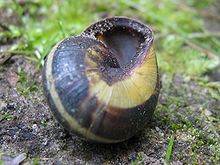- Peristome
-
The word peristome is derived from the Greek peri, meaning 'around' or 'about', and stoma, 'mouth'. It is a term used to describe various anatomical features that surround an opening to an organ or structure. The term is used in plants and invertebrate animals, such as in describing the shells of gastropod molluscs, i.e. snails.
Contents
In mosses
 Arthrodontous capsule of the moss Dicranella varia
Arthrodontous capsule of the moss Dicranella varia
In mosses, the peristome is a specialized structure in the sporangium that allows for gradual spore discharge, instead of releasing them all at once.
Most mosses produce a capsule with a lid (the operculum) which falls off when the spores inside are mature and thus ready to be dispersed. The opening thus revealed is called the stoma (meaning "mouth") and is surrounded by one or two peristomes. Each peristome is a ring of triangular "teeth" formed from the remnants of specially thickened cell walls. There are usually 16 such teeth in a single peristome, separate from each other and able to both fold in to cover the stoma as well as fold back to open the stoma. This articulation of the teeth is termed arthrodontous and is found in the moss subclass Bryopsida. In other groups of mosses, the capsule is either nematodontous with an attached operculum (as in the Polytrichopsida), or else splits open without operculum or teeth.
There are two subtypes of arthrodontous peristome.[1] The first is termed haplolepidous and consists of a single circle of 16 peristome teeth. The second type is the diplolepidous peristome fround in subclass Bryidae. In this type, there are two rings of peristome teeth—an inner endostome (short for endoperistome) and an exostome. The endostome is a more delicate membrane, and its teeth are aligned between the teeth of the exostome. There are a few mosses in the Bryopsida that have no peristome in their capsules. These mosses still undergo the same cell division patterns in capsule development, but the teeth do not fully develop.
In pitcher plants
In pitcher plants, the peristome is a reflexed ring (or partial ring) of tissue that surrounds the entrance to the digestive tube in these plants. It often (for example in Cephalotus and Nepenthes) possesses sharp, overhanging 'teeth' which aid in prey retention. It is often studded with nectar secreting glands, hence its popular name, nectar roll.
In shelled gastropods
Main article: Lip (gastropod)The peristome is the margin of the aperture of a gastropod shell. It is the edge of the lip of the shell. This part is sometimes reflected (turned back) or thickened once the snail reaches adult size, and these qualities of the peristome can be diagnostic features of the shell which may aid in identification of the species.
References
- ^ Edwards, S. R. 1984. "Homologies and inter-relationships of moss peristomes", pages 658-695 in R. M. Schuster (Ed.) New Manual of Bryology. (Japan: The Hattori Botanical Laboratory). ISBN 4-938163-3045.
Categories:- Plant anatomy
- Mollusc anatomy
Wikimedia Foundation. 2010.


